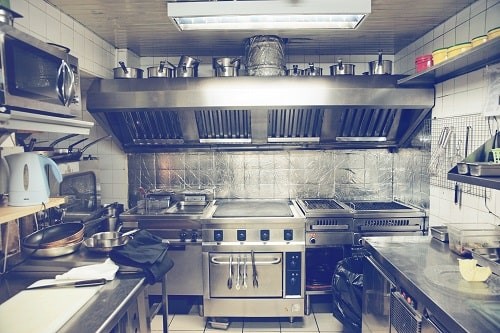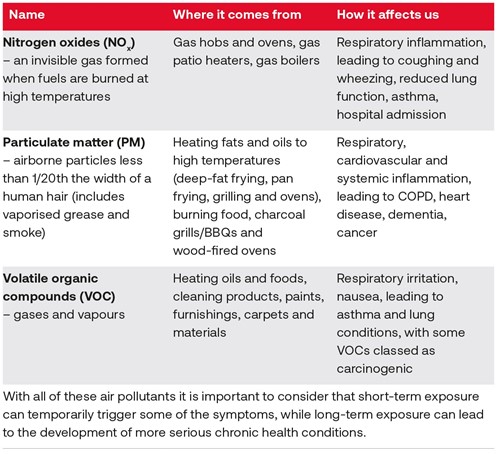Kitchens can be highly polluted working environments but there are options for making them safer and more sustainable.
Features
Too many broths spoil the cook: the hidden dangers of air pollution in commercial kitchens
Many of us perceive commercial kitchens as high-intensity, high-pressure workplaces thanks in part to the myriad television series and big-screen dramatisations about the culinary profession, but also because of an increasing societal awareness of how the stress of being a chef can have a serious impact upon health and wellbeing.
‘Stress’, ‘exhaustion’, and ‘burnout’ are words frequently used to describe working in a professional kitchen and these are usually associated with long and unsociable hours and the relentlessness of the work.
 If not properly managed, kitchen air pollution represents a significant occupational health hazard. Photograph: iStock
If not properly managed, kitchen air pollution represents a significant occupational health hazard. Photograph: iStock
Unfortunately, there is another insidious risk to the health of people employed in restaurants, cafés and other commercial kitchens: indoor air pollution. If not properly managed, kitchen air pollution represents a significant occupational health hazard, as well as potentially affecting the health of the surrounding community.
Fortunately, there are ways to reduce the risk, and the British Safety Council and Camden Council are leading the call for a national programme of action to draw attention to the issues while providing businesses and local authorities with the resources and funding necessary to evolve the sector to a more sustainable mode of operating. What is air pollution and how does it affect our health?
‘Air pollution’ refers to gases and particles in the air that can damage our health when we inhale them, and ‘air quality’ is a measure of the amount of air pollution in the air in a specific location.
There is now a considerable body of evidence showing how exposure to air pollution affects human health and it is broadly acknowledged as the largest environmental risk for public health.
Short-term exposure to high levels of air pollution can cause temporary respiratory discomfort. People with existing health conditions may experience more severe symptoms during serious pollution episodes such as those occurring during cold, still and settled weather, when outdoor pollution from vehicles and chimneys can easily build up.
Frequent high-pollution exposure (such as in a workplace) or sustained exposure to even moderately elevated levels for a long period (for example, if living in an area with poor outdoor air quality) can lead to more serious health consequences for previously-healthy individuals, who will be more likely to develop respiratory, cardiovascular and other serious conditions such as dementia later in life.
Air pollution can be a tricky thing to grasp; if we are in good health we may not feel its effects in any one moment, but it has a cumulative impact on our bodies over time. The health burden of air pollution is often measured in ‘equivalent’ deaths which is an indication of its overall contribution to mortality from the range of conditions mentioned above. It is estimated that as many as 36,000 equivalent deaths each year are attributable to air pollution in the UK, which is about 20 times more than the number of road collision fatalities.
 Air pollutants are produced when we burn fuels and other materials at a high temperature, including diesel, petrol, gas, wood, coal (and charcoal), cooking oils and food. Photograph: iStock
Air pollutants are produced when we burn fuels and other materials at a high temperature, including diesel, petrol, gas, wood, coal (and charcoal), cooking oils and food. Photograph: iStock
What causes it?
Air pollutants are produced when we burn fuels and other materials at a high temperature, including diesel, petrol, gas, wood, coal (and charcoal), cooking oils and food. We typically think of road vehicles, construction machinery, diesel trains, chimneys and gas boilers as being the main sources of the air pollution that we breathe, and many people only really think about air pollution when they are outside.
However, far from being a phenomenon contained exclusively to the outdoor environment, air pollution exists – and is often more severe – inside our homes and workplaces. Depending upon the nature of our activities indoors we can sometimes find that indoor air quality is much worse than outdoors.
Cooking is a major source of indoor air pollution and the degree of risk is related to the intensity of the activity as well as the cooking style and the presence (or absence) of any mitigation strategies such as ventilation or filtration.
In the typical kitchen environment we are likely to encounter the following types of pollutants – see table below.

What does the science say about air quality inside commercial kitchens?
In recent years there has been a push to better understand how different styles of cooking can affect air quality, and by association how this is likely to present a risk to the health of people who work in kitchens or live near to them.
Studies from Thailand to Norway have concluded that restaurant workers are more at risk of respiratory illnesses due to pollution exposure. Cooking style and cooking oils, time spent frying, kitchen size and output were all found to have an influence.
In one extreme case, a Chinese research project found that stir-frying led to a peak PM concentration of 20,000µg/m3 (micrograms per cubic metre of air) in one particular restaurant kitchen – more than one-thousand times higher than the World Health Organization’s (WHO) recommended 15µg/m3 24-hour limit. This means that it would only take a short amount of time with this level of air pollution for the recommended limit to be exceeded.
A one-off exposure to this environment could feasibly cause some respiratory discomfort for someone with existing health conditions but repeated exposure, shift after shift, may well have much more serious long-term health consequences even for previously healthy people.
It is not just frying; an Italian study identified that PM concentrations inside pizza restaurants with wood-fired ovens could reach 20 times higher than background (outdoor) levels.
Meanwhile, research in Portugal has found that charcoal grilling and wood ovens lead to the presence of carcinogenic hydrocarbons, while a Korean investigation concluded that proximity to charcoal grill restaurants was leading to a doubling of outdoor VOC levels compared with areas with no restaurants of this type.
Our own air quality work in Camden has added to this body of evidence. A research project commissioned by Camden Council and delivered by AmbioTEK measured PM levels inside several commercial restaurants and a student refectory, and found that pollutant concentrations were significantly higher than street-level pollution, regularly exceeding the WHO’s 24-hour guideline limit during operating hours.
The ‘takeaway’ message is that air pollution in commercial kitchens can easily reach levels far higher than outdoors, and significantly exceed health-focused limit values.
With data from the Office for National Statistics (ONS) showing that in 2017 there were 159,000 people employed as chefs in the UK (with 38,000 in London) it is clear to see that kitchen air quality is directly relevant to the health of a sizeable part of the UK workforce.
Do kitchens affect air quality outdoors?
London air quality modelling data from Imperial College London indicates that commercial cooking is a major source of PM emissions, at 15 per cent of the total in a city where 99 per cent of the population live in areas with pollution levels higher than the WHO’s annual mean guideline limit. In the London Borough of Camden, commercial cooking contributes 39 per cent of PM, making it the single largest source of this type of air pollution.
Evidently, communities with a prevalence of restaurants are likely to be exposed to higher levels of air pollution and as a result would be expected to have an elevated risk of developing associated health conditions.
So what do we need to do about it?
There are few regulatory requirements about air quality in commercial kitchens, and these primarily focus on the need for adequate ventilation for the avoidance of carbon monoxide (CO) build-up. Avoidance of CO is critical, but the regulations do not give appropriate consideration to the risk to health from air pollutants (NOx, PM and VOCs) which can be created even in the absence of any fuel combustion or CO.
So we need to take it upon ourselves – as individuals, businesses, councils and advocates – to affect positive change in the things that we can control, while also leading by example and advocating for a national programme of action to address the air pollution health risks faced by kitchen workers.
This should include best practice guidance and targeted financial support for businesses to make health-focused and sustainable choices about how kitchens are operated with respect to air quality.
Air pollution costs the UK several billions of pounds every year in health and social care, while the economic impacts are also believed to run into the billions because poor air quality in the workplace reduces productivity and cognitive performance, and because workers who become ill through air pollution need to take more time off.
It makes financial sense for us to tackle air pollution head-on. Research from the OECD concluded that the economic benefits from cleaner air would far outweigh the abatement costs; conversely each stepped increase in PM air pollution leads to a reduction in GDP.
We should advocate for action to transform the UK’s commercial kitchens for the protection of employee, customer and community health, and to improve business finances.
Camden Council has set out a programme of action to improve air quality and raise awareness whilst advocating for policy change at all scales, as part of our Clean Air Action Plan. Our long-term vision is for a borough where no person experiences poor health because of the air they breathe, including everyone employed in Camden.
What are the practical solutions?
There are things we can do right now to protect our own health (and the health of others) while working in a professional kitchen, and there are some things we can do with some targeted investment.
Immediate improvements:
1. Ventilation is everything – make sure ventilation equipment is used, routinely serviced and maintained, and filters changed as needed.
2. Ensure cooking surfaces are clean – burnt-on food and dripped sauces can be a source of indoor air pollution, so regular cleaning of cooking surfaces can help to avoid this.
3. Cover pots and pans – this will help to contain pollutants and will also reduce energy use, saving you time and money as well as helping to improve air quality.
4. Reconsider your cooking oils – use less oil where possible, use cooking vessels with a smaller surface area (less oil exposed to air), and select oils with a sufficiently high smoke point for the style of cooking to avoid burning.
With some investment:
5. Enhance ventilation and filtration – seek expert advice and ensure your premises has sufficient ventilation to extract pollutants from inside the kitchen area, while incorporating filtration and air purification to reduce the amount of pollution vented to the outdoors.
6. Consider indoor air quality monitoring – incorporate air quality sensors to monitor environmental conditions and to ensure behavioural changes (like cleaning) are being kept up.
7. Change cooking method – switch gas hobs for induction (electric), replace wood-fired pizza ovens with gas or electric, and use electric rather than charcoal grills. These changes will make a difference to indoor and outdoor air quality, benefiting staff, customers and the community, whilst also reducing climate impacts (electricity is much more efficient than gas, wood or charcoal).
What about sustainability in other aspects of our operations?
8. Support staff to travel sustainably to and from work – provide secure cycle storage, changing rooms and showering facilities.
Encourage customers to travel sustainably – signpost to walking, cycling and public transport options; discourage driving.
9. Get goods delivered sustainably – look at consolidated deliveries and waste collections made by cargo bikes rather than motor vehicles.
10. Ensure your premises is operating sustainably – make sure heating and ventilation controls are properly installed and used; ensure the building is insulated; use LED lighting throughout.
11. Replace and avoid gas patio heaters – these are a significant source of air pollution and climate change, and are less efficient and more expensive to run than electric radiant heaters (which also work better in windy weather).
The solutions exist, it just needs a mixture of awareness, impetus and support to make them happen, but the benefits for occupational health and wellbeing could be immense.
For more information see: camden.gov.uk/air-quality camden.gov.uk/clean-air-for-camden
Tom Parkes is Air quality programme manager at London Borough of Camden
FEATURES

Underpinning safety training with neuroscience for long lasting impact
By SSE Active Training Team (ATT) on 30 November 2025
A behavioural safety training programme developed by Active Training Team for energy provider SSE has been carefully designed with neuroscientific principles in mind – resulting in a prestigious industry award for Best Training Initiative in 2024.

Why a painted line will never be enough
By UK Material Handling Association (UKMHA) on 20 November 2025
Businesses that operate material handling equipment like forklifts are being urged to submit accident and near miss details to a new confidential reporting portal so the industry can identify what needs to be done to improve safety standards.

Why workplace transport training is changing in 2026 and what it means for employers
By AITT on 05 January 2026
New workplace transport training categories due in January mean it is essential to ensure operators of material handling equipment have the necessary training for the exact type of machine they use, and accredited training providers are an ideal source of advice and conversion training.



